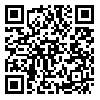Volume 26, Issue 1 (Spring 2025)
jrehab 2025, 26(1): 2-23 |
Back to browse issues page
Download citation:
BibTeX | RIS | EndNote | Medlars | ProCite | Reference Manager | RefWorks
Send citation to:



BibTeX | RIS | EndNote | Medlars | ProCite | Reference Manager | RefWorks
Send citation to:
Imani-Shakibayi M, Zarifian T. Investigating the Relationship Between Misarticulation of Polysyllabic Words and Predicting Later Reading Difficulties in Children With Speech Sound Disorder: A Narrative Review. jrehab 2025; 26 (1) :2-23
URL: http://rehabilitationj.uswr.ac.ir/article-1-3466-en.html
URL: http://rehabilitationj.uswr.ac.ir/article-1-3466-en.html
1- Department of Speech Therapy, Pediatric Neurorehabilitation Research Center, School of Rehabilitation, University of Social Welfare and Rehabilitation Sciences, Tehran, Iran. & Student Research Committee, University of Social Welfare and Rehabilitation Sciences, Tehran, Iran.
2- Department of Speech therapy, Pediatric Neurorehabilitation Research Center, Clinical Research Development Center, Rofeideh Hospital, School of Rehabilitation, University of Social Welfare and Rehabilitation Sciences, Tehran, Iran. ,ta.zarifian@uswr.ac.ir
2- Department of Speech therapy, Pediatric Neurorehabilitation Research Center, Clinical Research Development Center, Rofeideh Hospital, School of Rehabilitation, University of Social Welfare and Rehabilitation Sciences, Tehran, Iran. ,
Abstract: (3575 Views)
Objective Children with phonological disorders are at risk of long-term reading difficulties. This issue becomes particularly complex when children are confronted with co-occurring language impairment (LI). Given that polysyllabic words include the most similarity to connected speech, the present study employs a narrative review approach to examine the relationship between errors in the production of polysyllabic words and later reading problems in children with speech sound disorders (SSDs).
Materials & Methods A systematic search was conducted on March 3, 2023, in four online databases as follows: PubMed, Web of Science, Scopus, ProQuest, and Google Scholar Browser. The search terms used were “polysyllable” OR “multiyllable.” Articles between the years 1952 and 2023 were identified and entered into the Endnote software. No restrictions were placed on the language of the sources or review articles. All sources about the relationship between the production of polysyllabic words and phonological awareness/reading in children with SSDs, and employing the perceptual method, in which the participants were under 18 years of age, were included.
Results A total of 1736 sources were initially identified, with duplicates removed. Of these, 72 sources on the production of polysyllabic words were examined in full, and five articles on the relationship between the production of polysyllabic words and phonological awareness/reading ability were qualitatively examined. The most valuable criterion that can determine the relationship between the accuracy of speech and the subsequent development of reading is the accuracy of phonological representation. To verify the accuracy of phonological representation, it is crucial to consider the type of speech errors and the complexity of the speech stimulus. Atypical errors have been demonstrated to be associated with children’s performance on phonological awareness/reading. The results of the present review, which examined the effect of the accuracy of polysyllabic words in predicting reading problems, demonstrated that errors of omission, atypical speech errors, and the accuracy measure of polysyllabic words accounted for the greatest variance in phonological awareness skills.
Conclusion Atypical speech errors and the omission of polysyllabic words during the preschool period can diagnose speech sound disorder and subsequent reading difficulties, as well as receptive components of language. Polysyllabic words are more suitable for identifying children’s errors due to their greater phonemic information and similarity to connected speech. Consequently, it is recommended that they be included in the evaluation package, along with the phonological awareness test.
Materials & Methods A systematic search was conducted on March 3, 2023, in four online databases as follows: PubMed, Web of Science, Scopus, ProQuest, and Google Scholar Browser. The search terms used were “polysyllable” OR “multiyllable.” Articles between the years 1952 and 2023 were identified and entered into the Endnote software. No restrictions were placed on the language of the sources or review articles. All sources about the relationship between the production of polysyllabic words and phonological awareness/reading in children with SSDs, and employing the perceptual method, in which the participants were under 18 years of age, were included.
Results A total of 1736 sources were initially identified, with duplicates removed. Of these, 72 sources on the production of polysyllabic words were examined in full, and five articles on the relationship between the production of polysyllabic words and phonological awareness/reading ability were qualitatively examined. The most valuable criterion that can determine the relationship between the accuracy of speech and the subsequent development of reading is the accuracy of phonological representation. To verify the accuracy of phonological representation, it is crucial to consider the type of speech errors and the complexity of the speech stimulus. Atypical errors have been demonstrated to be associated with children’s performance on phonological awareness/reading. The results of the present review, which examined the effect of the accuracy of polysyllabic words in predicting reading problems, demonstrated that errors of omission, atypical speech errors, and the accuracy measure of polysyllabic words accounted for the greatest variance in phonological awareness skills.
Conclusion Atypical speech errors and the omission of polysyllabic words during the preschool period can diagnose speech sound disorder and subsequent reading difficulties, as well as receptive components of language. Polysyllabic words are more suitable for identifying children’s errors due to their greater phonemic information and similarity to connected speech. Consequently, it is recommended that they be included in the evaluation package, along with the phonological awareness test.
Keywords: Polysyllables, Developmental reading disabilities, Speech sound disorder (SSD), Misarticulation, Phonological impairment
Type of Study: Systematic Review |
Subject:
Speech & Language Pathology
Received: 28/03/2024 | Accepted: 25/11/2024 | Published: 1/04/2025
Received: 28/03/2024 | Accepted: 25/11/2024 | Published: 1/04/2025
Send email to the article author
| Rights and permissions | |
 |
This work is licensed under a Creative Commons Attribution-NonCommercial 4.0 International License. |








